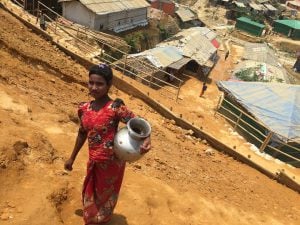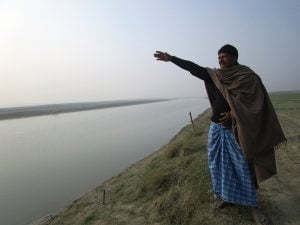Responding to a Right to Information request, the Indian government recently revealed that its flagship project to clean the Ganga, Namami Gange, was doing far from well. Parts of the river are now more polluted than they were back in 2014 when the clean up project began. According to the government response the river is still absorbing waste from 144 drains of the five states that Ganga passes through, namely Uttar Pradesh, Uttarakhand, Bihar, Jharkhand and West Bengal.
The Ganga and its various tributaries have been the source of livelihood for many who live on its banks. With the increase in the level of pollution in the river and as a consequence degradation in the quality of the river, the lives of the people who have traditionally lived by the bank and earned their living from it have suffered tremendously.
Opposite the Hanuman Setu temple in Lucknow is the Gomti riverbank that serves as the site of livelihood for many different communities such as washer-men, boatmen and shopkeepers selling herbal medicines. Once upon a time, there were fisherfolk too, but no more, since there are no fish. There is a cemented slope lined with trees and yellowing grass at the bank. There is a set of steps leading down to the bank where the water is clean, and the water flow is comparatively strong, as a barrage upstream channels the flow to this bank.
Shahzad Alam, a washerman, rides his bicycle from his home in Kaiserbag– about three kilometres away – with his load of washing everyday. His home has a water tap, but there isn’t enough water for him to be able to wash so many clothes every day. “Due to the barrage, the river is cleaner in this part now than it was before. We have been asked to move away from here many times so that the water remains clean. But no alternate provision has been made for us to wash clothes,” he says.
Less than 500 metres away is the temple, which sees a crowd of visitors and devotees everyday. A group of boatmen gather along the riverfront. Suresh Kashyap, a boatman, says he and other boatmen keep this part of the river clean. While rowing, they use a floating screen to sift out the solid waste. But with waste from ongoing construction adding to the rubbish, the clean-up is a constant struggle.
Gomti, one of the major tributaries of the Ganga which flows through the capital of India’s most populous state Uttar Pradesh, is half choked with water hyacinth here. A few steps lead down to the water where a dilapidated boat lies by the bank. The water is murky, with solid waste floating on top. Boating has become extremely difficult due to this. “We clean the river daily for a fee of INR 100 (USD 1.46) to INR 200 (USD 2.92). This money is given to us by the devotees who float lamps and flowers in the river after having visited the temple,” says Kashyap, who comes from a family of boatmen.
There is no government initiative to help the boatmen. “We have often saved people from drowning and have been promised cash reward for it by the government and the police alike. However, we have never received any monetary compensation or aid,” Kashyap says. The boatmen are often called by the police to nearby Indira Canal to save people who might have accidentally fallen in or jumped in to kill themselves. The families of the victims do pay them, but not the authorities.
About 20 years ago, the Gomti was cleaner along its Lucknow stretch because there was less rubbish and more water to flush the rubbish away. But now barrages upstream have reduced the water flow, while ongoing construction of houses and at the temple has led to more rubbish being thrown into the river, including thousands of plastic bags. Kashyap says if they ask people not to throw rubbish into the river, they are either ignored or abused.
The water flow does improve during the monsoon months from June to September, but a drain nearby carries untreated sewage to spoil the water quality throughout the year. The river is often smelly, and some days people don’t even want to walk near its banks due to the stench.
When the Gomti had more water and it was cleaner, it was the main source of fish for the residents of Lucknow and a source of livelihood to many fishermen. Now the water is so dirty and so scanty that all the fish are dead. The fishermen go to the fish market if they want a fish. “Our families are in a very bad state. We have young children at home but no source of livelihood to feed them or send them to school,” says Kashyap.
Under the bridge that crosses the Gomti at this point is a cement house, where Rajpati lives with her family of six. She has lived here for 15 years. They are labourers and have built their house here due to lack of space anywhere else. There is a water connection in the temple nearby, which is used by the family for drinking and washing.
“Our house gets flooded during the rainy season. We have to move to the shanty on the upper side of the bank,” says Rajpati. They use the river water for washing clothes. There are four other families living there. “We are here because there is no land available anywhere else. There are mosquitoes here and frequent flooding for two to three months at a stretch.” Officials often ask them to move away, and they have to plead to be allowed to stay on.
Sewage treatment
There are two major sewage treatment plants (STPs) in Lucknow, in Daulatganj and Bharwara. These STPs were designed to cater to the city’s population according to the 2001 census. They are overwhelmed now.
There is an ongoing project to enhance the capacity of the STP at Daulatganj from 56 MLD (million litres per day) to 72 MLD. Even with that, the total capacity of the two STPs will be to treat 100 MLD, while the sewage load is 140 MLD now. The Lucknow Water Institute of the Lucknow Municipal Corporation is setting up two new STPs – at DH Canal Road and Bijnor Road. The STP at DH Canal Road has been inaugurated by the Chief Minister, though it is not working yet.
But it is an ongoing struggle. “There isn’t enough water in the river. The levels improve in the rainy season but gets polluted and stagnant within a day. Therefore, we are in the process of setting up new STPs by the end of the year,” says S.K. Jain, Chief Engineer of the Lucknow Water Institute.
The problem is compounded because there is fertiliser and pesticide runoff from farms upstream, so the river suffers from eutrophication – excessive enrichment of the water.
Rapid construction along the riverbank and degradation of water quality in the Gomti has led to the loss of livelihood for many. As the government sets up more STPs under its flagship programme to clean the Ganga and its tributaries, it remains to be seen if it will also do something to help the people who have already been affected by the state of the river.
![<p>There is barely any water, much less clean water, flowing in the Gomti as it crosses Lucknow [image: Wikimedia Commons]</p>](https://dialogue.earth/content/uploads/2018/07/Gomti_Lucknow_Wikimedia_Commons.jpg)







